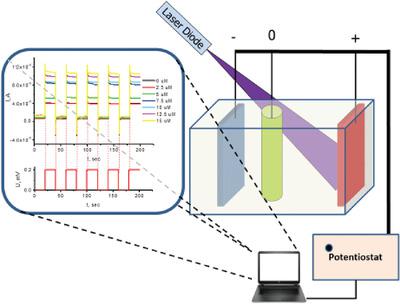当前位置:
X-MOL 学术
›
Macromol. Chem. Phys.
›
论文详情
Our official English website, www.x-mol.net, welcomes your feedback! (Note: you will need to create a separate account there.)
Photoelectrochemical Bisphenol S Sensor Based on ZnO‐Nanoroads Modified by Molecularly Imprinted Polypyrrole
Macromolecular Chemistry and Physics ( IF 2.5 ) Pub Date : 2019-11-28 , DOI: 10.1002/macp.201900232 Roman Viter 1, 2 , Kwanele Kunene 3, 4 , Povilas Genys 5 , Daniels Jevdokimovs 1 , Donats Erts 1, 6 , Andris Sutka 1, 5 , Krishna Bisetty 3 , Arturs Viksna 4 , Almira Ramanaviciene 5 , Arunas Ramanavicius 5
Macromolecular Chemistry and Physics ( IF 2.5 ) Pub Date : 2019-11-28 , DOI: 10.1002/macp.201900232 Roman Viter 1, 2 , Kwanele Kunene 3, 4 , Povilas Genys 5 , Daniels Jevdokimovs 1 , Donats Erts 1, 6 , Andris Sutka 1, 5 , Krishna Bisetty 3 , Arturs Viksna 4 , Almira Ramanaviciene 5 , Arunas Ramanavicius 5
Affiliation

|
Molecularly imprinted polymers are important tools for the design of sensors and other molecular recognition based analytical systems. In this paper the development of a photoelectrochemical sensor for selective bisphenol determination is reported. The sensor is based on a glass/ZnO/MIP‐Ppy structure consisting of glass modified by a ZnO layer (glass/ZnO), which is functionalized by molecularly imprinted conducting polymer polypyrrole (MIP‐Ppy). The sensitivity of the sensor to bisphenol is in the range of 0.7–12.5 µm. Selectivity tests to other bisphenolic compounds are performed. Some aspects of a photoinduced response mechanism in glass/ZnO/MIP‐Ppy nanostructures are predicted and discussed.
中文翻译:

分子印迹聚吡咯修饰的基于ZnO-纳米路的光电化学双酚S传感器
分子印迹聚合物是用于传感器和其他基于分子识别的分析系统设计的重要工具。本文报道了用于选择性双酚测定的光电化学传感器的开发。该传感器基于玻璃/ ZnO / MIP-Ppy结构,该结构由经过ZnO层(glass / ZnO)改性的玻璃组成,该结构通过分子印迹导电聚合物聚吡咯(MIP-Ppy)进行功能化。传感器对双酚灵敏度是在0.7-12.5μ的范围内米。进行了对其他双酚类化合物的选择性测试。对玻璃/ ZnO / MIP-Ppy纳米结构中光诱导响应机制的某些方面进行了预测和讨论。
更新日期:2019-11-28
中文翻译:

分子印迹聚吡咯修饰的基于ZnO-纳米路的光电化学双酚S传感器
分子印迹聚合物是用于传感器和其他基于分子识别的分析系统设计的重要工具。本文报道了用于选择性双酚测定的光电化学传感器的开发。该传感器基于玻璃/ ZnO / MIP-Ppy结构,该结构由经过ZnO层(glass / ZnO)改性的玻璃组成,该结构通过分子印迹导电聚合物聚吡咯(MIP-Ppy)进行功能化。传感器对双酚灵敏度是在0.7-12.5μ的范围内米。进行了对其他双酚类化合物的选择性测试。对玻璃/ ZnO / MIP-Ppy纳米结构中光诱导响应机制的某些方面进行了预测和讨论。


























 京公网安备 11010802027423号
京公网安备 11010802027423号